etc. etc.
Saturday, April 27th, 2024
As Paul McCartney, after 50 years, officially releases his most bootlegged album ‘One Hand Clapping’, a collection of live recordings he made with Wings at Abbey Road Studios in London, we remember David Litchfield’s description of how he came to film a 1-hour video documentary of those recordings – (and draw the art work for the album jacket):
Litchfield first met Paul and Linda McCartney, as well as David Bailey, around 1972 at a fund raising party for Release at the Hard Rock Café in London, organised by the artist, journalist and political activist Caroline Coon. At the time, he was designing, editing and publishing a ‘breathtakingly beautiful graphic arts magazine’ (Hercules Bellville) called The Image. As a result of Bailey’s further introductions, David came to publish both Jean Shrimpton’s and Linda McCartney’s photographs in his magazine.
‘The Image had only lasted for two years [1972-4]. When it crashed, Paul McCartney fulfilled me creatively and saved me financially by generously commissioning me to make three documentaries: One Hand Clapping, concerning McCartney and Wings; Empty Hands about a Japanese v British Karate contest, after which I went on to film a stage version of Steven Berkoff’s Fall of The House of Usher and Harry Nilsson’s The Point. I even got the funding to make a documentary about Bob Marley, before Jerry Weintraub, Bob’s tour manager, arrived in London and threatened to kill me, if I continued with the project’.
‘During this time we spent a considerable amount of time at Abbey Road filming Wings, and at my studio in Kilburn, discussing the meaning of life’.
(as published in David Litchfield’s book “Bailey and I”, IPN/Jan.2023)
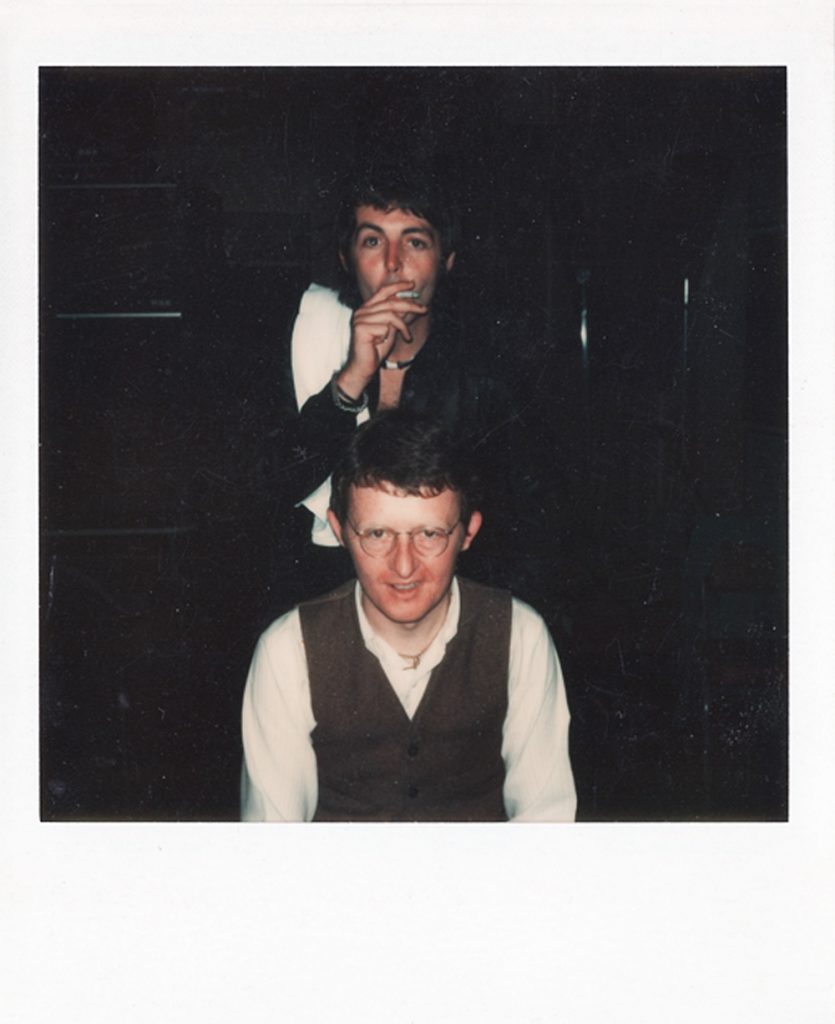 PAUL MCCARTNEY AND DAVID LITCHFIELD DURING THE FILMING OF ‘ONE HAND CLAPPING’ IN 1974 (DAVID ROBERT LITCHFIELD ESTATE)
Tags: Abbey Road Studios, Bob Marley, Caroline Coon, David Bailey, David Litchfield, David R. L. Litchfield, Empty Hands, Harry Nilsson, Hercules Bellville, Jean Shrimpton, Jerry Weintraub, Karate, Kilburn, Linda McCartney, One Hand Clapping, Paul McCartney, Steven Berkoff, The Fall of The House of Usher, The Image, The Point, Wings
Posted in etc. etc. Comments Off on How David R L Litchfield came to film ‘One Hand Clapping’ for Paul McCartney and Wings
Friday, August 31st, 2018
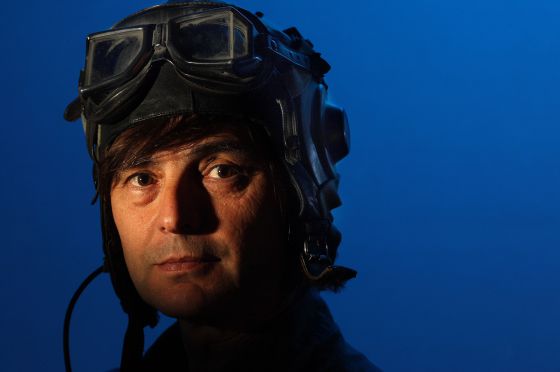 Jacinto Anton (photo: copyright El Pais) (Translated from Spanish by Caroline Schmitz – Original article: ‘La Valkiria que cabalgaba con los SS’ in the El Pais newspaper in Spain and Brazil on 11/15 August 2018)
|
I would not say that I heard them ride from when I was a child, as they said Wagner did, but since my earliest memories, I have always had a weakness for valkyries; and for amazons: in fact for all wild and war-like women. Brunhilde, Sigrún, Waltraute (named after the Rhine wine), Skuld, Gunr, Orlind or Göndul are some of those supernatural maidens, who ‘assign death and hand over victory’ and who, in nordic mythology, gather a battle’s most valient fallen, taking them to Valhalla, where they are installed by Odin in Vingölf’s famous hall of 540 doors, to assist him once Ragnarök makes his entry at the end of time.
In modern times, the most notable valkyrie, operatic versions apart, has been Valkyrie Mitford, the fifth of the six famous, aristocratic Mitford Girls, those celebrities (before the term was coined) who seemed to have sprung from the feather of Evelyn Waugh or Noël Coward and who, in the 1930s, and later, caught the imagination of the British as representatives of their country’s upper class. Sister of the famous Nancy, Diana and Deborah (who became the Duchess of Devonshire, a great friend of and letter writer to Patrick Fermor Leigh, who, in turn, was a friend of mine, which would have given me a direct link with the Mitfords, had they not all been dead by then). Since her baptism and even before, as her parents said she was conceived in the village of Swastika in Ontario, Unity Valkyrie Freeman-Mitford (1914-1948) – this was her full name – seemed destined to cause a big mess.
And thus it happened: ferocious germanophile since childhood, Valkyrie (her name was given to her because of a friendship of her grand-father with Richard Wagner) became a crafty Nazi, a furious anti-semite, and managed, at twenty years of age, not only to meet Adolf Hitler but to form part of his intimate nucleus of friends, a detestable group in which she was never out of place (she never failed to denounce those who questioned the regime and installed herself in a flat requisitioned from a Jewish couple, which she started redecorating while the evicted coupled were still packing up their belongings). The infamous Julius Streicher let her speak at his gatherings and write articles in his antisemitic newspaper. Eva Braun was jealous of her.
I thought that the young Brit, whom they called Bobo, was nothing more than an eccentric rebel, naive, with little brains and considerable psychological imbalances. I thought that through her bad girl behaviour she had tried to gain notoriety and to scandalise her family and British society (including giving the Hitler salute when out in Chelsea and giving public speeches to say she would kill the Jews). It is true that the girl, the black sheep of the Mitford family – although there were quite a few – was very close to Hitler, whom she called by the familiar ‘you’ and who showed his appreciation of her (in his singular way of showing appreciation) by installing her in a flat. But I believed that there was much fantasy in what she recounted of her experiences and what she said about herself. In other words, I thought Unity was a kind of ‘narrow-gauge’ valkyrie.
However, after reading the biography Hitler’s Valkyrie. The uncensored biography of Unity Mitford (The History Press), by the writer, journalist and documentary film maker David R. L. Litchfield, I was left stunned. The author, who had access to new documentation, partly for family reasons as his mother and grand-mother knew Unity, traces a completely different portrait from the one I had formed for myself of this young woman. And one which is, without the shadow of a doubt, a much more interesting one.
He explains that, far from being stupid and innocent, Unity was an avid reader of William Blake and had an outstanding gift for drawing nude, copulating figures (she said they were ‘fallen angels’), if nothing else. And so it is that her biography, which is very well written and speckled with bitingly stimulating passages and an irony worthy of Truman Capote or Terenci Moix, starts with a description of one of the orgies which she held as valkyrie with members of the SS whom she called familiarly storms, for ‘Sturmführer’. Litchfield explains how Unity took six SS-men to her flat in pre-war Munich, let herself be bound to the bed surrounded by Nazi flags, her eyes bound with a swastika ribbon, and was taken by them while the Horst Wessel Song, the iconic Nazi hymn, played in the background. As we can see, this was no ‘narrow-gauge’ valkyrie at all. Rather it seemed we were in the days leading up to Salon Kitty or The Night Porter, but Litchfield assures us that the erotic painting of the ‘Sturms and Drang’, which he says was repeated frequently, was absolutely real and witnessed by Unity’s sister, Diana (another ‘brown’ Mitford: she too admired Hitler and married Oswald Mosley, the leader of the British Nazi Party), who surprised her one time in flagranti. Diana not only did not reproach her younger sister for her behaviour, but had SS lovers herself, ‘though only one at a time’.
The promiscuous valkyrie, who liked to dress up all in black, played out these acts as a form of mystical ceremony of surrender to people ranked between her and her adored Führer, Adolf Hitler. The biographer affirms that Hitler himself knew of these parties with a happy ending and took them as an exciting compliment. It has always been debated whether Hitler and Unity, who had a strong and healthy appearance of an aryan woman with bright blue eyes as favoured by the Nazi leaders, ever got down to the business (even a love child was rumoured to exist, who was said to be living in Britain today). Litchfield does not think they ever did but that their relationship stayed on a purely platonic-morbid level. For Unity, who venerated Hitler, it was practically impossible to consummate her love with him as he represented for her a divinity. Hitler himself, though the aristocracy favoured him, was aware of the political problems if he were to engage with a British woman, even though she was extremely Nazi – and even more so with one who had been to bed with half the Leibstandarte SS. It seems that there was nevertheless one instance when Adolf decided to have a go; he invited Unity for an intimate rendez-vous to the chancellery where she discovered her beloved Führer had prepared a bottle of champagne for them on a table.
Finally, the relationship entered a more pathological and ‘necromantic’ stage when she decided to die for him and Hitler convinced her that her mission was to be a ‘personal valkyrie’ for him, and wait for him on the other side.
There was nothing banal or posed about the coming together of Unity and Hitler. Rather it was planned meticulously. After abandoning the heavily attended 1933 party rally, at which, as for other party events, the Mitford family occupied VIP seats, she spent months hanging out at the favourite places he frequented, until finally one day, he invited her to his table at the Osteria Bavaria in Munich. It was the 9th of February 1935 (‘the happiest day of my life’, as she wrote). Thus began their relationship. They met on at least 140 separate occasions, including, obviously, at the Bayreuth Music Festival, to which he invited her, giving her tickets to very good seats.
In the end, on 3 September 1939, Unity shot herself in the head with a small calibre Walther in the Englischer Garten when she heard that Great Britain had declared war on Germany. It is curious how many women around Hitler shot themselves: his niece Geli, Eva Braun, Magda Goebbels. Unity Valkyrie did not die (the whole incident is surrounded by conspiracy theories and rumours) and Hitler arranged for her to be transferred to her country, where she lived, mystifyingly without being sentenced as a traitor or even investigated, until she died in 1948, due to the late effects of the wound she had sustained (but not before she had seduced an RAF pilot). It appears that the news of Hitler’s suicide pained her much, as she felt she had let him down in her role as his personal valkyrie.
There are some revelations in the biography which I had difficulty believing, such as Unity losing her virginity to her brother-in-law Mosley on a billard table. But of course it is suggestive. The best thing is that Litchfield takes one on a voyage far away from here where the snobbish Mitfords await us, especially their mother, Lady Redesdale, a malicious witch whose ambition, he says, was to marry off her daughter to Hitler. He calls them the ‘first family of fascism in Great Britain’. He insists that Unity was not an exception (with Diana), as they said afterwards, but the product of a way of thinking that they all had (only the youngest, the communist Jessica, was different), which was the characteristic of the British aristocracy at the time, whose offspring were keen on the Nazi uniforms and what was inside of them. Antisemitism was rife in this class, as was the idea of racial hygiene, although, according to Litchfield with his customary sarcasm, they stopped short of demanding the sterilisation of alcoholics, as this would have decimated their own families.
It is unsurprising that a veil of silence and oblivion descended on this period after the war and that the image of this valkyrie was turned into that of an ugly duckling, eccentric and ideologically ghastly, even if with time they came to call her out more as a goose.
Practising auto-erotic asphyxiation with the brother of ‘the English patient’
Through the magnificent biography of Lászlo Almásy, the real person who inspired the novel and film The English Patient, by John Bierman, I already knew of the intimate relationship between Unity Mitford and the elder brother of the explorer, Janos Almásy, a corrupt man and associate of the Nazis. But Litchfield discovers morbid aspects of this relationship, so for instance that the valkyrie and the lord of Bernstein Castle (the Almásy family castle on the border of Austria and Hungary), astrologer and satanist of repute, officiated necromantic rites in the castle and engaged in sado-masochist practices, including the auto-asphyxiation using a silk cord, which Unity wittily called ‘my little gaspers’. The young Brit got to know Janos as he, a bisexual, had had a relationship with her brother Tom, another Mitford jewel, who was also an admirer of the Nazis and refused to fight them in Europe. They sent him to fight the Japanese instead and a sniper shot him dead in Burma. Having visited Bernstein Castle I can vouchsafe for its strange atmosphere – including certified ghosts – and of its rich library of occult books. Unfortunately I was then more interested in Count Almásy and his experiences in the desert than in his brother’s adventures with Unity. Who knows what other secrets I could have discovered during that long night within the walls of the Almásys’ castle where the valkyrie’s little gaspers must still resonate.
(Jacinto Antón – El Pais Spain/Brazil- August 2018)
|
|
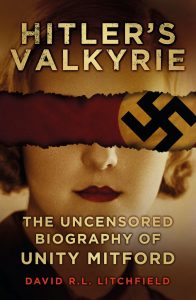 |
Tags: Adolf Hitler, antisemitism, Austria, auto-erotic asphyxiation, Bayreuth Music Festival, Bernstein Castle, Brazil, Burma, David R. L. Litchfield, Duchess of Devonshire, El Pais, Englischer Garten, Eva Braun, Great Britain, History Press, Hitler's Valkyrie. The uncensored biography of Unity Mitford, Horst Wessel Song, Hungary, Jacinto Anton, Janos Almasy, John Bierman, Julius Streicher, Lady Redesdale, Laszlo Almasy, Leibstandarte SS, Magda Goebbels, Mitford Girls, Munich, necromantic rites, occult books, Ontario, Osteria Bavaria, Oswald Mosley, Patrick Fermor Leigh, racial hygiene, Richard Wagner, Salon Kitty, Spain, SS lovers, Sturmführer, Swastika, Terenci Moix, the English Patient, the Mitfords, The Night Porter, Truman Capote, Unity Mitford, Unity Valkyrie Freeman Mitford, Valhalla, valkiria, valkyries, William Blake
Posted in etc. etc. Comments Off on The valkyrie who rode with the SS, by Jacinto Anton, in El Pais, August 2018
Tuesday, March 17th, 2015
|
I didn’t write this book because I particularly wanted to, but because I was invited to do so. However, this request never assumed the celebrated status of a ‘commission’, for before we got to that stage, it was ‘suggested’ by the publisher that the character that I would be writing about was an unattractive, unintelligent, clumsy lump of a girl who had a romantic crush on Adolf Hitler. Unfortunately this was not the character that had previously been described to me by various friends and relatives; including my own mother. She was, in fact, quite the opposite.
Unity Valkyrie Freeman Mitford was physically attractive, free-spirited, athletic and highly intelligent. She was also a committed fascist who was quite determined to meet and have an affair with Hitler, while enjoying various other sexual adventures on the way. All in all, a far more interesting subject for a biography. So I decided to proceed, with another publisher.
It may seem puzzling that such a book hadn’t already been written because, God knows, there had been no shortage of books concerning the Mitford girls and the family in general. But before the War their Nazi sympathies were not particularly unusual amongst the privileged classes. Afterwards it was a somewhat different story; particularly for ‘Debo’ in her new role as The Duchess of Devonshire and saviour of Chatsworth House.
To this end the Duchess took it upon herself to polish the Mitfords’ tarnished reputation by ‘encouraging’ their portrayal as beautiful and charming eccentrics which reflected everything that was glorious about the English aristocracy. So successful was she in this endeavour that the Mitford girls soon became an icon which those with more social ambition than distinction could aspire to. Some of them even formed a little society and labelled themselves ‘Mitties’. Something that would of course have quite appalled the Mitfords themselves.
In truth they weren’t really a very ‘nice’ family, apart from Jessica; the token black sheep, committed communist and favourite of J K Rowling’s; and perhaps Pamela, once she had become a lesbian and ceased to be mentioned. Otherwise they were outrageous snobs, malicious bullies, and doubtless right-wing fascists who were vehemently committed to Nazi principles. Predictably the ‘Mitties’ do not share my views and reacted to the publication of ‘Hitler’s Valkyrie’ with caustic indignation and vitriolic criticism. But that doesn’t prevent the story of the relationship between Unity Mitford and Adolf Hitler remaining quite fascinating.
http://www.dailymail.co.uk/news/article-2455171/Unity-Mitford-English-debutante-staged-Nazi-orgies-Hitler-lost-virginity-Oswald-Mosley.html
http://www.thehistorypress.co.uk/index.php/hitler-s-valkyrie-24723.html
http://www.amazon.co.uk/Hitlers-Valkyrie-Uncensored-Biography-Mitford/dp/0750960884/ref=sr_1_1?ie=UTF8&qid=1426422617&sr=8-1&keywords=hitlers+valkyrie
|
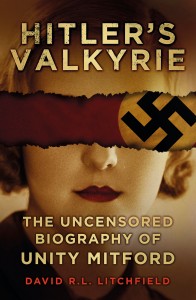 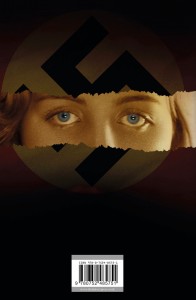
|
|
Tags: Adolf Hitler, Biography, Daily Mail, English aristocracy, History Press, Hitler's Valkyrie, J. K. Rowling, The Duchess of Devonshire, The Mitford Girls, The Mitties, Unity Mitford, Unity Valkyrie Freeman Mitford
Posted in etc. etc. Comments Off on Hitler’s Valkyrie – The Uncensored Biography of Unity Mitford
Monday, May 17th, 2010
Dear Francisco Valdepenas Maruenda,
In answer to your question concerning my work as a painter, I have nothing small enough to scan in, so I have included an illustration I did for the documentary I made for Paul McCartney. Funnily enough, it also seems to have some relevance for the unfolding story of Tita Cervera and the El Mundo revelations concerning her alleged use of her son Borja’s sperm for the impregnation of the surrogate mother of her adopted ‘angels’.
To see the film, click here: http://www.youtube.com/watch?v=CG0oS14pOhE (unfortunately, the video has now been removed)
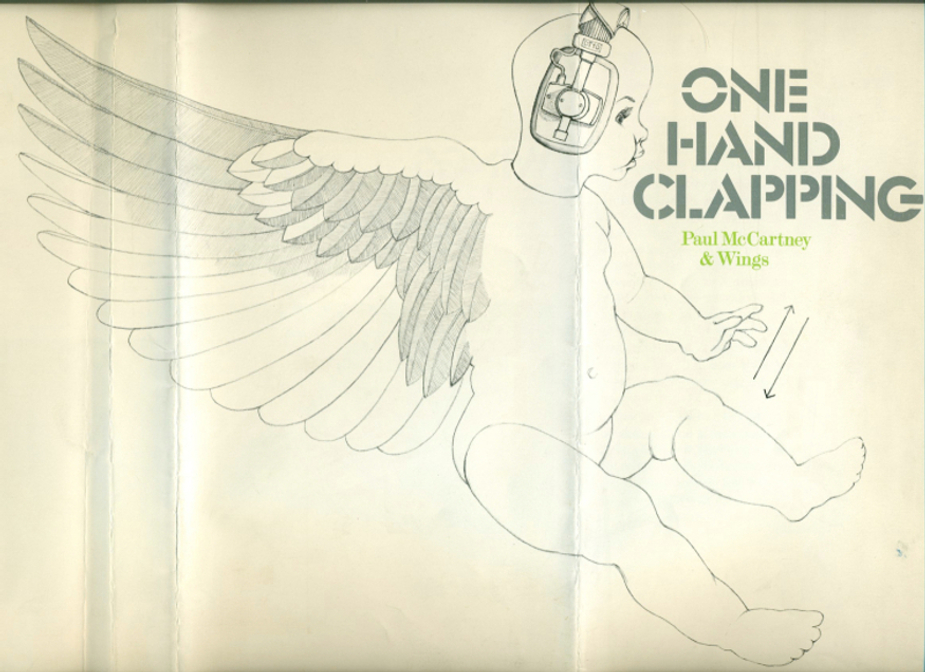
Tags: El Mundo, Francisco Valdepenas Maruenda, Paul McCartney, Tita Cervera
Posted in etc. etc. Comments Off on All My Own Work
Tuesday, April 27th, 2010
| With good bars increasingly under threat from smokers and Starbucks, property developers and all sorts of shit, in this occasional series I will endeavour to feature a number of bars that have played an important part in my life and, with a bit of help, will continue to do so for some time to come.
I can’t remember the correct name for The Little Horseshoe in Le Marais (all good bars have an alternative name used by regular patrons), but when I lived in Paris, just around the corner from Le Beaubourg, it was the bar of choice.
It also had a small restaurant in the back, where a number of English embarrassed themselves one night by indulging in the English obsession with food throwing. When they returned the next day to apologise, they found the owner proudly showing the remains, which were still stuck to the walls and ceiling, to impressed natives.
The value of bars as centres of social interaction should not need explaining, nor the reason why such interruptions and distractions as mobile phones, laptops or any other alternative to ‘direct’ social interaction are unwelcome.
For those of you who also fail to understand why Parisian barmen and waiters appear so rude, it is a self-imposed discipline which they adopt so that they can gradually slacken off as an encouragement when you continue to return. Amateurs, who go to a different bar every night in desperate search of a welcome, remain terminally frustrated.
(For more of Hector McDonnell’s work, see:
www.hectormcdonnell.com). |
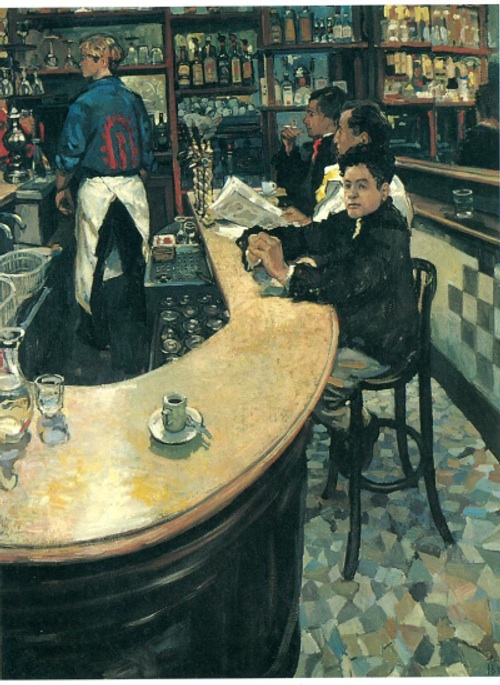 'The Little Horseshoe', Paris, 1994, by Hector McDonnell |
Tags: Bars, food fights, Hector McDonnell, laptops, Le Beaubourg, Le Marais, Little Horseshoe Bar, mobile phones, Paris, Parisien barmen, Starbucks
Posted in etc. etc. Comments Off on Support a bar – or more!
Wednesday, April 22nd, 2009
Fellini once said:
“The pearl is an oyster’s autobiography”.
This is my grain of sand.

|
 |
Posted in etc. etc. Comments Off on
|










